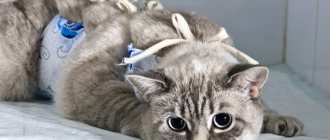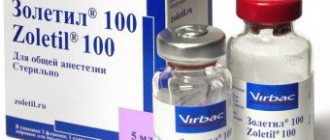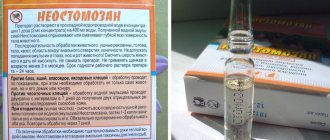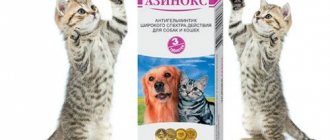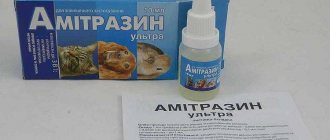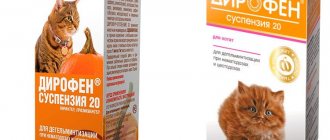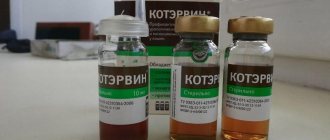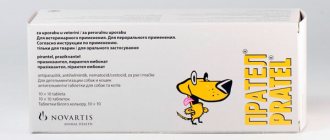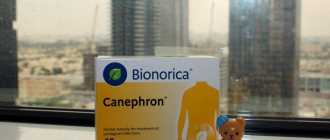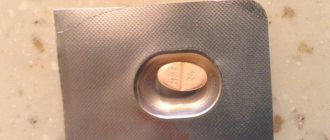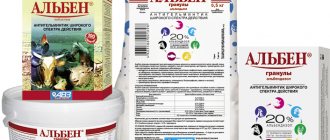Piperazine is a generic anthelmintic drug that can be used for humans, cats and other animals. The medicine is considered safe and effective, however, its effect only applies to roundworms. Like any medicine, it has a number of restrictions on its use, so you should consult your veterinarian before use.
general description
Piperazine is an anthelmintic drug that contains the active substance of the same name. For animals, it is available in the form of a white crystalline powder. It is packaged in plastic bags of different capacities - from 2 to 150 grams. Sold only in veterinary pharmacies. Since there is now a huge selection of wide-spectrum anthelmintics, the demand for this drug is low, which is why it is often unavailable in pharmacies.
For people, the drug is available in the form of white tablets. They are packaged in cell blisters or paper packages of 10 pieces. The active substance content in one tablet is 500 mg. Also contains calcium stearate and starch. The tablets are also used for animals, including cats.
The medicine should be stored in a dry place protected from ultraviolet radiation. The air temperature can range from 5 to 25 degrees Celsius. Shelf life – 3 years from the date of production.
Note! Piperazine can be given to cats, but only for therapeutic purposes and after the type of parasite has been identified. To prevent helminthic infestations, it is better to choose a broad-spectrum agent that can provide protection against both roundworms and tapeworms.
Release form and composition
Piperazine is available in the form:
- Tablets.
- Solution for internal use.
Piperazine tablets are available in paper sheets of 6 or 10 pieces. Piperazine solution for internal use is available in a volume of 100 ml.
Piperazine tablets are white tablets without shades or inclusions. The main active ingredient is piperazine adipate in a dosage of 0.5 g of the substance in one tablet. The solution contains 50 mg of piperazine adipate per 100 ml.
Patients who want to get rid of helminths often ask for natural remedies with the least side effects. In such cases, I recommend this remedy.
Elixir destroys and removes from the body adults, as well as larvae and eggs of absolutely all types of parasites. Helps cleanse organs and tissues, neutralizes intoxication throughout the body.
Operating principle
The anthelmintic is effective only against nematodes. Its effect does not apply to tapeworms. The drug is considered safe due to the peculiarities of its principle of action. The fact is that the medicine does not kill parasites, but causes paralysis in them, affecting the nervous system. Muscles lose the ability to move due to disruptions in the transmission of nerve impulses.
Since the parasites do not die, the risk of intoxication of the animal is eliminated. They do not emit dangerous toxins that can have a negative effect on the liver and other organs. Paralyzed parasites leave your pet's body naturally, so there is no need to give him a laxative or give him an enema to flush out his intestines.
The drug is highly effective. Its bioavailability (absorption) is 90-95%. Characteristic of the medicine is its rapid action. It is excreted from the body along with urine. If the recommended doses are followed, Piperazine does not accumulate in the body, does not have a toxic effect on the liver, and does not affect the development of offspring, but before use you should consult a doctor.
Side effects
Although piperazine is a relatively safe drug, the following possible side effects are possible when using it:
- unusual gait;
- vomit;
- diarrhea;
- softening of the stool.
If you overdose on the drug, more serious side effects such as allergic reactions or paralysis may occur. It is important to immediately show the animal to a veterinarian.
Piperazine is not recommended to be combined with other anthelmintics, in particular with pyrantel.
When will they be applied?
Piperazine is used for cats with the following pathologies:
- with uncinariasis;
- with toxascariasis;
- with toxocariasis;
- with hookworm;
- with trichocephalosis.
The drug can also be used to treat mixed invasions, but in this case a combination with other drugs may be required.
For prevention, it is better not to use the medication due to its limited spectrum of action.
Indications
Piperazine can and should be given to a cat for worms, but only if there is a need for it. The problems that this medicine helps fight include :
- Trichacephalus (caused by the round helminth whipworm);
- Uncinarium (caused by uncinarium nematode);
- Hookworm (causative agent - hookworm);
- Toxacaridiasis (caused by Toxocara entering the body).
Pipezarin can also be used for mixed helminths.
With just one dose of the drug, a cat can get rid of more than 90% of the helminths parasitizing in its body, and after completing a full course of treatment, it can completely eliminate them.
Scheme and dosage of use
The instructions for use for Piperazine tablets are written for people, so when using them for cats, you must strictly adhere to the recommendations of your veterinarian. In most cases, one dose is enough to completely get rid of parasites. If the infection is severe, you may need to take the medicine again over time. A re-appointment may be required after 1-3 weeks, depending on the severity of the disease and the risk of re-infection.
The dosage of Piperazine for cats is calculated according to a simple scheme - 1 tablet per animal weighing 4-5 kg. For kittens, half a tablet is usually sufficient, although the exact dose must be calculated by the doctor. If powder is used, then per 5 kg of weight you need to take 1 g of medicine.
Piperazine: instructions for use for people, animals; analogues
whether the medicine helped or did not help get rid of the disease, what complications and side effects were observed, perhaps not stated by the manufacturer in the annotation. Piperazine analogues in the presence of existing structural analogues. Use for the treatment of ascariasis, enterobiasis and other worms in adults, children, as well as during pregnancy and lactation. Composition of the drug.
Piperazine is an anthelmintic drug. It has a paralyzing effect on nematodes, disrupting the function of their neuromuscular system.
Compound
Piperazine adipate excipients.
Indications
Release forms
Tablets 200 mg and 500 mg Adipinate.
Instructions for use and dosage
Adults - single dose 1.5-2 g.
- 13-15 years - single dose 1.5 g;
- 9-12 years - single dose 1 g;
- 6-8 years - single dose 750 mg;
- 4-5 years - single dose 500 mg;
- 2-3 years - single dose 300 mg;
- up to 1 year - single dose 200 mg.
It is also possible to use it within one day: once from 400 mg to 4 g (depending on age) or 2 times from 200 mg to 2 g.
For enterobiasis, it is used in the same doses for 5 days in a row, 1-3 cycles of treatment are carried out with a 7-day break. In between cycles, it is recommended to prescribe an enema at night (to remove pinworms from the rectum): for adults - from 4-5 glasses of water, for children - from 1-3 glasses of water (with the addition of sodium bicarbonate, 1/2 teaspoon per glass of water) .
Side effect
- nausea;
- stomach ache;
- transient headache;
- neurotoxic complications;
- tremor;
- muscle weakness.
Contraindications
- organic diseases of the central nervous system;
- hypersensitivity to piperazine adipate.
Use during pregnancy and breastfeeding
Not contraindicated during pregnancy and breastfeeding.
Use in children
It is possible to use the drug in children at the age-specific dosages indicated above.
special instructions
The use of piperazine does not require preliminary preparation of patients and the appointment of a special diet. Laxatives are prescribed only if you are prone to constipation (on days you take piperazine in the evening). When treating enterobiasis, strict adherence to a hygienic regime is necessary.
Drug interactions
When used in combination, piperazine increases the severity of extrapyramidal disorders caused by chlorpromazine.
Concomitant use with pyrantel is not recommended.
Analogues of the drug Piperazine
Analogs for therapeutic effect (anthelminthics):
- Biltricide;
- Vermox;
- Vormin;
- Gelmodol VM;
- Helminthox;
- Dekaris;
- Mebendazole;
- Medamin;
- Nemozol;
- Nemocid;
- Pyrantel;
- Pyrantela pamoate;
- Pyrvinium;
- Sanoxal;
- Telmox 100.
Piperazine is added to wet food for animals. To do this, grind the tablet into powder and mix it with food. The medicine should be given once a day in the morning. For small animals the drug is given at a dose of 0.5 g per kilogram of weight once, and for large animals - 15 g. After three weeks, for the purpose of prevention, the procedure can be repeated. Sometimes veterinarians suggest a different treatment regimen. The dosage is calculated based on the degree of infection, age and health status of the animal.
After anthelmintic treatment of cows and goats, it is prohibited to consume their milk for two days.
During and for a week after treatment, you must adhere to the following rules:
- Do not give the animal milk or dairy products.
- Cook and stew meat products.
- Do not give other medications.
How to give?
And although the effect of the anthelmintic does not depend on food intake, it is better to give the drug in the morning before feeding. In this case, it is better to feed the animal after 30-40 minutes. You can feed the medicine in different ways:
- Crush the tablet into powder and mix with a small amount of food that the animal likes. Depending on taste preferences, this could be canned food, minced meat or other delicacies.
- Dissolve the crushed tablet in water. Give your pet a drink with the prepared solution. It is best to use a syringe without a needle or a bulb with a soft tip for these purposes. This method is good for kittens, as well as animals that have poor appetite and refuse food.
- Forcefully place the tablet on the root of the tongue. This method is the most unpleasant for animals, but the most effective, since the medicine will enter the body in the required dose. The main thing is to make sure that the cat swallows the tablet and does not spit it out. To prevent your pet from scratching during the procedure, wrap it in a towel or blanket.
If medicine is added to food, it must be hot. High temperatures may reduce the effectiveness of the medicine.
When and How to Use Piperazine for Cats
Piperazine for cats – anthelmintic drug in the form of powder or tablets
One of the most common diseases in cats is helminth infestation. Both walking pets and domestic cats that do not leave the apartment can become infected. Today there are many drugs in the anthelmintic spectrum, but Piperazine for cats is one of the most common.
Composition and action
The drug is indicated for deworming domestic animals. It contains the active ingredient piperazine adipate, which is effective against nematodes – roundworms.
The active substance piperazine adipate has a paralyzing effect on helminths, disrupting their muscle and nervous activity. Paralyzed worms fall off the intestinal walls, but do not die, which eliminates the cat’s intoxication, but are released naturally from the animal’s body during defecation.
The medicine is considered harmless according to the following indicators:
- does not have a toxic effect on the cat’s liver;
- does not affect the reproductive sphere;
- does not interfere with the development of offspring.
Therefore, it is prescribed for infestations not only in cats, but also in small kittens. The advantages of the drug Piperazine are as follows:
- has high efficiency;
- does not have an accumulative property;
- excreted from the cat’s body in urine within 24 hours;
- has a high speed of impact;
- has bioavailability (drug absorption) within 95%.
Thanks to these properties of the drug, infestation in cats is completely cured in one course.
Purpose
It is not recommended to give piperazine to cats as a prophylactic agent. If the type of helminths is not established, then the result may be zero, because Piperazine effectively fights only nematodes. The medicine is prescribed for the following diagnoses:
- hookworm (causative agent - hookworm);
- trichocephalosis (when a cat’s intestines are infected with roundworms, whipworms);
- toxascaridosis (caused by the toxascarid nematode);
- toxocariasis (infestation by Toxocara)
- uncinarium (pathogen is the nematode uncinarium).
In just one dose of the drug, the cat gets rid of 90% of the parasites in its intestines. Even with severe infection, it is necessary to give the medicine only three times, while the effect of Piperazine is 100%.
Dosage
Despite the low toxicity of the drug and its harmlessness for cats, Piperazine must be dosed very carefully, taking into account the weight of the animal. It is recommended to use powder for cats rather than tablets from a regular pharmacy. If it is not possible to purchase the medicine at a veterinary pharmacy, then you can crush a Piperazine tablet intended for treating humans.
A course of taking Piperazine powder involves:
- use of 0.5 g of active ingredient per 1 kg of cat’s weight;
- single dose to the root of the animal's tongue. You can dissolve the powder in water and drink it through a syringe without a needle, or mix it with your favorite food;
- repeat with the same dosage after 21 days.
With this medication, complete elimination of helminths in feces occurs. In case of severe infection, the course of treatment differs from the standard:
- 0.5 g piperazine per kilogram of cat's weight once a day;
- repeat the dose for three days.
If tablets from a regular pharmacy are used, the dosage is as follows:
- for a cat weighing 4-5 kg – 1 tablet of Piperazine;
- kittens over 14 days old are given a standard dose of 0.5 g/1 kg of kitten weight.
Taking into account the cat’s condition, the veterinarian may prescribe a different course, but it is necessary to strictly follow all the doctor’s instructions and prescriptions. The drug is best given an hour before meals, or an hour after. To avoid re-infestation, veterinarians advise treating your cat against fleas and ticks with insecticidal drops on the withers, even if there is no visible presence of ectoparasites.
Limitations and side effects
Although the medicine is considered harmless, there are restrictions on taking Piperazine.
In what cases should cats not be given the drug:
- kittens under 14 days of age;
- in case of intolerance to the components of the drug;
- with increased sensitivity to the medicinal component;
- with a predisposition to allergies;
- for liver and kidney diseases;
- for disorders of the nervous system;
- with poor functioning of the digestive system.
Pregnant and lactating cats can use Piperazine only as prescribed by a doctor. The anthelmintic should not be used in combination with other anthelmintic drugs containing pyrantel.
Side effects may occur when taking the drug:
- nausea, vomiting;
- loose stools;
- impaired coordination of movements;
- tremor - involuntary twitching and trembling of the paws.
In case of individual intolerance, allergic manifestations are possible - rash and redness of the skin. In rare cases, anaphylactic shock, in which case immediate contact with a veterinarian is required.
Analogs
Today there are many medicines that are non-toxic and successfully fight helminthic infestations. They are available in various dosage forms: tablets, drops, powders, suspensions. Piperazine analogues are:
- Pratel;
- Prosicite;
- Drontal;
- Milbemax.
The cost of the drug is low and affordable (11-15 rubles for 10 tablets in a regular pharmacy, the powder is more expensive - 500 rubles for 45 g), so the decision on which medicine to use is decided by the owner of the animal together with the veterinarian.
Existing restrictions and side effects
Piperazine should not be given to cats in the following cases:
- with increased sensitivity and intolerance to components;
- with reduced activity of the digestive system;
- up to 2 weeks of age.
If the animal has severe kidney and liver diseases, it is better to avoid using an anthelmintic. In some cases, its use is permitted under the supervision of a doctor. In this case, a specialist should monitor the pet’s vital signs.
Piperazine can be given to pregnant and lactating cats, but only as directed by a doctor.
Note! It is strictly forbidden to combine the use of the medication with other anthelmintic drugs, in particular with Pirantel.
The anthelmintic may cause the following side effects:
- diarrhea;
- vomiting;
- impaired coordination of movements;
- tremor of the limbs.
If the animal has an intolerance to the components, there is a high risk of developing allergic reactions. Depending on the individual characteristics of the pet, they can manifest themselves in different ways, but most often these are skin rashes, redness, and less often - anaphylactic shock.
Contraindications, possible harm
The instructions for using Piperazine for a cat contain information that this anthelmintic drug should not be given to an animal that has an individual intolerance to the active component. Only a veterinarian can prescribe medication when it is truly warranted, so it is imperative to seek their advice.
Contraindications also include pathologies of the cat’s liver or kidneys, disruptions in the pet’s nervous system, and a predisposition to allergic reactions.
Let us note the side effects that may occur if Piperazine is given to a cat. There are several of them:
- Nausea and vomiting;
- Abnormal stool (diarrhea);
- Visible loss of coordination of movement.
It is important for every person who has a cat to understand that he bears full responsibility for its health. Given their small size, parasites can cause enormous harm, even the death of the animal, so they should be immediately gotten rid of with the help of an effective veterinary drug
Piperazine is a generic anthelmintic drug that can be used for humans, cats and other animals. The medicine is considered safe and effective, however, its effect only applies to roundworms. Like any medicine, it has a number of restrictions on its use, so you should consult your veterinarian before use.
Advantages and disadvantages
Piperazine has several important benefits:
- It is highly efficient. Usually one dose is enough for the worms to completely leave the animal’s body.
- It is considered a universal anthelmintic. Can be used for people and animals.
- Easy to dose. One tablet is required for a medium-sized adult cat.
- Can be used in different ways - with water, stern, in its pure form. Each owner can choose the best option taking into account the characteristics of the pet.
- Suitable for cats of different breeds and ages. Can be used for kittens from 2 weeks of age.
In addition, the drug is a budget medicine. The price of a package of Piperazine (10 tablets) starts from 15 rubles. You can buy it in almost any pharmacy for people. A doctor's prescription is not needed for this.
The main disadvantage of the medicine is that it only affects roundworms. For this reason, it is not suitable for prophylaxis. The disadvantages include side effects, although they occur rarely.
You can now see the current price of tablets and buy them right here:
Piperazine for cats dosage tablets
Large farm animals and small domestic animals are vaccinated to avoid contracting serious diseases. Before the first procedure, the animal must be given an anthelmintic. Veterinarians often recommend the use of Piperazine.
Piperazine is a general purpose anthelmintic that can be used on humans, livestock, domestic cats and dogs. The drug is active against a number of helminth species. It is characterized by low toxicity and reasonable cost.
Owner reviews
Vadim, owner of a 4-year-old cat:
“To be honest, our family has many years of experience using Piperazine for cats, but after the last case, my attitude towards it has changed significantly. When the next time for deworming came, out of habit I gave the cat one tablet, but his reaction shocked me. Vaska began to walk around the apartment like a drunk, staggering in different directions, and then fell into a heavy sleep. When I woke up, I lay next to the bowl and periodically lapped water. The cat left for a few more days. I will not use this medicine in the future.”
Lyudmila, owner of a Persian cat:
“When Jessica was diagnosed with worms, the veterinarian prescribed the drug for 300 rubles. It's expensive for me, so I decided to look for an alternative. I decided on Piperazine. 10 tablets cost me 12 rubles. After taking the medication, the worms came out of the cat on the second day. No side effects were noticed. Excellent and cheap product."
Scope of application
The spectrum of action of the product is narrow. It is prescribed when the following diagnoses are made:
- Infection with roundworms (especially chicken ascariasis);
- Passalurosis in rabbits;
- Amidostomiasis in waterfowl (especially geese);
- Toxocariasis in cats and dogs;
- Neoascariasis in cattle;
- Parascariasis in horses;
- Ascariasis of pigs.
Theoretically, chickens can also take it for preventive purposes, since this is the type of infestation that occurs most often in them. However, due to the narrow spectrum of action of the drug, there is a high probability of becoming infected with something else.

